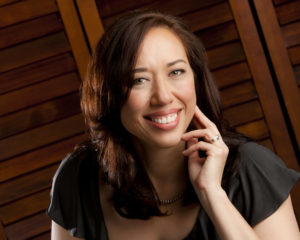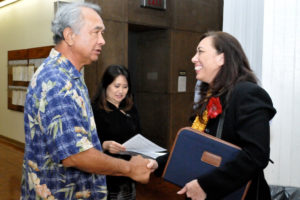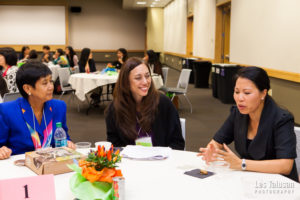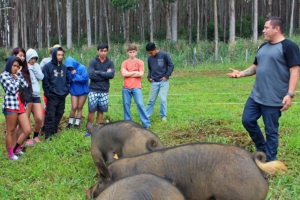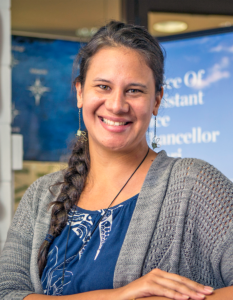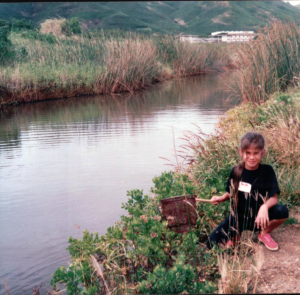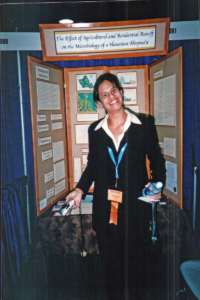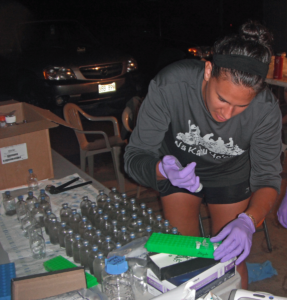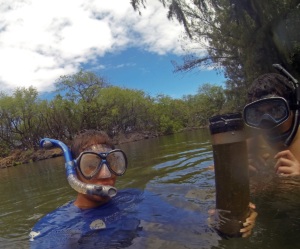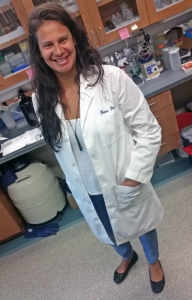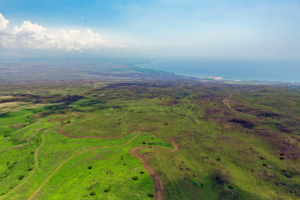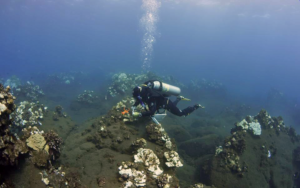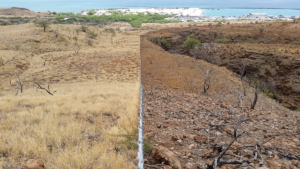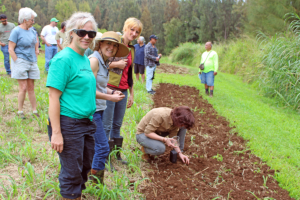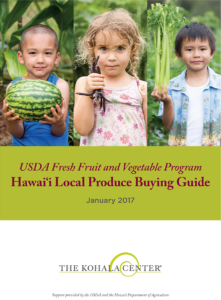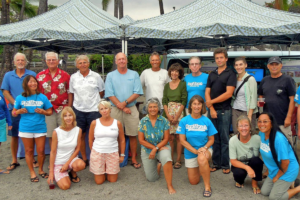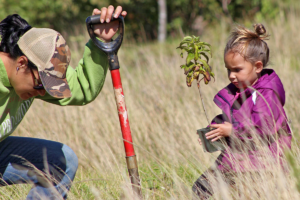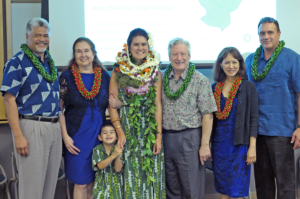IN THIS ISSUE
PEOPLE: Cheryl Ka‘uhane Lupenui joins The Kohala Center as president and chief executive officer
FOOD: Farmer training programs advance careers of local food producers
WATER: Adding a layer of contemporary science to expand ancestral wisdom
PLACE: Community partnership turns watershed restoration into economic opportunity
Program News
Upcoming Events

Cheryl Ka‘uhane Lupenui joins The Kohala Center as president and chief executive officer
Cheryl Ka‘uhane Lupenui
In the same spirit in which The Kohala Center was founded, Cheryl Ka‘uhane Lupenui firmly believes that Hawai‘i’s ‘āina and ancestral wisdom are foundations of learning that can influence local and global resilience. We are pleased to welcome Lupenui, founder and principal of an indigenous leadership practice called The Leader Project, to our ‘ohana as president and chief executive officer effective July 3.
Born in Washington, D.C., Lupenui arrived in Hawai‘i to start college, studying international business at the University of Hawai‘i at Mānoa (UH Mānoa) and McGill University in Montréal before earning her master’s degree in business administration from Tulane University. She then followed a diverse career pathway through for-profit and nonprofit organizations, as well as several entrepreneurial ventures. From her 30-year career in Hawai‘i, she brings to The Kohala Center a multidisciplinary skillset that includes business and program development, systems-level policymaking, capital improvement project planning and management, fundraising, community engagement, and strategy and leadership development.
Lupenui’s career started as a business development associate at one of Hawai‘i’s largest businesses, but her entrepreneurial spirit soon guided her to open a restaurant that promoted sustainable agriculture by serving healthy meals made with locally grown produce. Her restaurant management experience led her to the Young Women’s Christian Association (YWCA) of O‘ahu, where just four years later she became the organization’s chief executive officer—the youngest in its history and the first of Native Hawaiian descent. During her 10-year tenure as CEO she helped launch a re-branding effort, a $12 million capital campaign to renovate Laniākea, the organization’s historic downtown facility, and an $8 million campaign to expand transitional housing for women and fitness and meeting facilities for the community. Hawai‘i Business Magazine named her as one of “25 People Who Will Shape the Next 25 Years” in 2007.
Lupenui, Hawai‘i Board of Education member from 2011 to 2015, meeting the late State Sen. Gilbert Kahele (Photo by Ed Morita)
In 2011 Lupenui launched The Leader Project, a business that sources from Hawaiian and Western models to develop leadership capacity throughout organizations. Spanning multiple sectors such as transportation, education, health, human services, and public safety, her practice is based on building leadership, in which all group members share the responsibility of leading and following.
When asked about why she started The Leader Project, Lupenui recounts her conversation with husband and Hawaiian fine artist Boots Lupenui. “After so many years in social services I had this mindset of ‘what do people need?’ One night I asked Boots, ‘what do Hawaiians need? How can I best serve Hawai‘i and our people?’ And he calmly responded, ‘‘Maybe it’s not what we as Hawaiians need, but what the world needs from us Hawaiians.’ The Leader Project was born that day for me to be a place of strength in the field of leadership from Hawai‘i, for Hawai‘i.”
At the same time she started The Leader Project, Lupenui was appointed by the Governor to the Hawai‘i Board of Education (BOE) for a four-year term. While there she helped develop a new BOE/Department of Education Strategic Plan and several policies that created the Office of Hawaiian Education, Office of Community Engagement, and Nā Hopena A‘o, or HĀ (breath), a set of system-wide learning outcomes for the Hawai‘i State Department of Education grounded in Native Hawaiian culture.
Lupenui providing leadership development for the Center for Asian-Pacific American Women (Photo by Les Talusan)
Since the year 2000, The Kohala Center has conducted research and created programs based on the expressed needs and aspirations of island residents. With this mission in mind, Lupenui recently shared what led her to The Center. “My work in recent years has focused on seeing place, culture, community, and leadership as a whole ecosystem,” she said. “The Kohala Center is rich with these same elements that can guide our islands in policy and practice. People seem to know The Kohala Center through a relationship with one or more of its individual environmental and educational programs. I am beginning to see a moku (district, island) united in defense of aloha ‘āina to sustain healthy food, water, and energy practices.
“Following a path to Kohala continues my journey emerging from single practitioner to a community of practice. I see a team of bold leaders making a positive impact and transmitting their stories to guide and strengthen each generation that follows.”
For Lupenui, coming to The Kohala Center to serve as our new president and CEO is, in a sense, coming home. “The ‘Āpa‘apa‘a wind of Kohala breeds a strong and resilient place and people, my own ancestors among them,” she said, “My great-great grandmother was born in Kohala and lived here her entire life, yet many of her children felt they had to leave Kohala to have a better life. Joining The Kohala Center feels more like a return home. I now see coming back to Kohala as a better life!”

Farmer training programs advance careers of local food producers
Since 2013, more than 160 Hawai‘i Island residents have enrolled in one of our farmer training programs to gain a comprehensive understanding of what it takes to succeed in farming and food production in Hawai‘i. We recently caught up with a current student, a program graduate, and a participating mentor to find out how our educational and technical assistance programs have helped them plan, launch, and expand their agricultural business endeavors.
Support from the U.S. Department of Agriculture’s National Institute of Food and Agriculture and Office of Advocacy and Outreach Program 2501, the County of Hawai‘i Office of Research and Development, and Kamehameha Schools has enabled us to offer seven sessions of our Beginning Farmer-Rancher Development Program over the past four years. The program goes far beyond the basics of how to grow crops, covering subjects such as building soil fertility, integrated pest management, cover cropping, marketing, business planning and financing, accounting, livestock production, and food safety. Program graduates who complete a business plan are eligible for assistance in applying for farm leases and capital to successfully produce, market, and distribute their products.
Brandon Lee
Honokaʻa native Brandon Lee and his wife enrolled in the second cohort of our farmer training course in 2013 with an interest in becoming producers of premium-quality pork. When Lee opened Nāpua at Mauna Lani Beach Club restaurant in 2010, he was committed to sourcing fresh, local ingredients as much as possible, and quickly learned how challenging that was. The limited availability of quality local meats and produce inspired him to investigate farming and ranching as an additional business. “We enrolled in The Kohala Center’s farmer training program thinking it might actually deter us from pursuing farming because of the amount of work we knew would be involved,” Lee recalls. “The sessions were convenient and thorough, and provided a mix of classroom and on-farm instruction. The Center connected me with an internship at Āhualoa Hog Farm, which gave me hands-on experience with the aspects of pig farming I wasn’t sure I could do.”
In addition to Nāpua, Lee now also owns and operates Kaunāmano Farm, which he launched on the Hāmākua Coast with farmer Max Bowman after winning a landlease and financial support in the 2014 Mahi‘ai Matchup Agricultural Business Plan Competition sponsored by Kamehameha Schools and the Pauahi Foundation. Lee specializes in raising Berkshire pigs—“the best pigs in the world,” he says—using an organic, humane, open-pasture system. The knowledge he gained in our farmer training program helped him understand operational processes like rotational grazing, cover cropping, and record keeping, and gave him an appreciation for food production he feels would benefit every restaurateur. “Knowing what I know now, I wish I had taken the farmer training course and opened a farm first before a restaurant,” Lee said. “I think if you wanted to open a restaurant but had to open a farm first, you’d have many more successful restaurants because owners don’t know how food works. It’s given me a better understanding of how and where food starts and how to value it.”
Max Bowman
Bowman, also originally from Honokaʻa, never took a farmer training course but learned the ropes on the job at Nalo Farms on O‘ahu. “Initially working at Nalo Farms was just a job. I didn’t really approach it as a training or mentorship opportunity,” Bowman says. “But [owner] Dean Okimoto was always helpful and willing to answer questions, and I learned a lot about field work, packing, distributing, and delivery there. So I got a comprehensive look at the whole business” before moving back to Hawai‘i Island to start ‘Ano‘ano Farms in 2011. With a loan he secured from the Hawaii Department of Agriculture, Bowman was able to lease five acres of state land managed by the Hāmākua Agricultural Cooperative.
Bowman’s success and his appreciation of the knowledge he gained in his first farming job inspired him to serve as a mentor to three of our farmer training students and graduates so far. “Mentorship can be a great way to apply what you’ve learned in a training course and get a real sense of what it’s like to actually farm,” Bowman said. “But it’s only beneficial if a mentee takes it seriously and treats it like a real job. If anything, it can help a potential farmer decide if they really have the drive and discipline required to succeed. I see it as a stepping stone for getting a job on an existing farm, where you can gain even more knowledge and experience before trying to start your own.”
Recently The Kohala Center introduced Bowman to Chris and Ginny Robb, longtime owners of Robb Farms who were preparing to retire and were seeking an experienced farmer to take over their certified-organic operation in Waimea. The connection led to Bowman and his brothers acquiring the farm, ensuring that the ‘āina carefully managed by the Robbs will continue to be nurtured by an experienced farming family and provide an abundance of organic vegetables to Hawai‘i consumers.
Dr. Angela Fa‘anunu
Dr. Angela Fa‘anunu and her sister Kalisi are students in the current cohort of our farmer training program. They along with two colleagues took first place in the 2016 Mahi‘ai Matchup competition and won a five-year lease on 9.5 acres of land in the Pāhoehoe ahupua‘a north of Hilo. Their plan is to start an agro-forest farm featuring ‘ulu (breadfruit) and cassava (tapioca) as food crops and wauke (paper mulberry) and hala (panadus) as fiber crops to support traditional Polynesian practices of weaving and making kapa. They decided to enroll in our course to gain a better understanding of the science and theory behind farming and to be surrounded by others with similar interests.
“We chose our primary crops not only for their cultural significance to us as Pacific Islanders but because they are resilient plants that grow well without constant care,” Angela Fa‘anunu said. “We grew up in a village in Tonga’s outer islands and fishing and farming was our lifestyle. We didn’t have electricity or a refrigerator to store food. We grew crops to eat so farming was an important part of our lives.”
Today, their lives in Hawai‘i are very different, with both sisters working full-time jobs; modern conveniences like supermarkets and electricity make it easier to detach from the land. “For us, the farm has become an opportunity to figure out how to be modern Pacific Islanders who can navigate the capitalist world while being rooted in our cultural traditions and do our part to contribute to our communities,” Fa‘anunu said. “Visiting farms on Hawai‘i Island through the farmer training program allows us to learn about what happens on our island and the challenges that local farms face. The stories of the farms we visit and the other students in our class inspire us as we begin our journey on our own farm.”
Our farmer training courses are designed to give students practical knowledge of the scientific and business aspects of food production, but starting and maintaining a farm or ranch is still challenging, especially in Hawai‘i where land and agricultural inputs are expensive. While The Kohala Center offers technical assistance to program graduates who complete business plans, ambition, perseverance, and creativity are essential to achieving success. Lee, Bowman, and Fa‘anunu all agree that the considerable investment of time and energy can be extremely rewarding.
“Aside from increasing the supply of local food and reducing the amount of food we need to ship in from elsewhere, what I really like about farming is that there’s a direct, proportional relationship between what you put into it and what you get back from it,” Bowman said. “And I think that’s rarely the case in most jobs. You can scale your operation based on what you’re willing to get out of it. The harder you work, the greater the return.”
“If I hadn’t taken The Kohala Center’s class I wouldn’t have become a farmer,” Lee said. “It gave me a chance to see if it was for me, and to meet other farmers because you want to make sure you’re not the only crazy one. Because everyone tells you farming is hard work. I don’t think it is. It’s good work. It’s pleasant work. For me it’s not nearly as hard as sitting in an office all day. I’m not doing it to make millions. I’m doing it for quality of life.”
“Why do we farm? Because it is part of who we are and I want my six-year-old daughter to grow up understanding what that means,” Fa‘anunu said. “I think what I appreciate most about the farmer training program is being part of a group of people who value local food production, agriculture, and the sustainability of our islands. Time spent at the farm, working the land and being surrounded by the sounds and smells of the bush, the blue skies, the rain, it makes me feel alive.”

Adding a layer of contemporary science to expand ancestral wisdom
Dr. Kiana Frank
When Dr. Kiana Frank was a young girl growing up in Kailua, Ko‘olaupoko, O‘ahu, her great-grandmother shared a mo‘olelo (oral history) with her about sweet-tasting mud in nearby Kawainui Marsh. Her quest to find this legendary lepo ‘ai ‘ia was her first step toward a career as one of Hawai‘i’s experts in aquatic microbes and the role they play in sustaining healthy ecosystems.
Currently an assistant professor at the Pacific Biosciences Research Center at UH Mānoa and a postdoctoral fellow in The Kohala Center’s Mellon-Hawai‘i Doctoral and Postdoctoral Fellowship Program, Frank recounted how she would go to the marsh as a child and taste different muds in hopes of finding the magical sweet mud. “I tasted red mud, green mud, black mud,” she recalls, “and while I never found the sweet mud, I did notice differences between them. Why does the black mud smell bad? Why does red taste like rust, and why does green sort of taste like limu (seaweed)?”
That initial practice of kilo, of careful observation, fueled her passion to engage with the ‘āina and connect what she experienced with the mo‘olelo of her upbringing. As her relationship to ‘āina deepened, she realized that she wanted to protect and defend Hawai‘i’s cultural and environmental resources when she grew up. She decided early on that she would become a lawyer.
Frank’s interest in aquatic ecosystems dates back to her childhood, growing up near the Kawainui Marsh in Kailua, Ko‘olaupoko, O‘ahu
In Frank’s freshman year at Kamehameha Schools–Kapālama, her biology teacher asked her what she wanted to be when she grew up. “My teacher told me I would be a terrible lawyer! I was crushed,” Frank said. “But she gave me an application to a summer science institute and suggested I apply for it.” Frank ended up attending, and acknowledges that her teacher was right. “Science was perfect for me because I’m a fact follower. I’m not interested in ‘spin’ or picking sides. I like asking questions and following facts, I like engaging with places and literally getting my hands dirty. Science lets me do all of that, not to mention the uniform suits me better.”
While in high school, Frank became curious about the aquatic ecosystems in and around Kailua, and collected samples of microbes from all of the streams in the Ko‘olaupoko moku—from headwaters to the ocean. During the course of her own field research and analysis, she recognized the limitations of current microbiological methods and developed cutting-edge techniques to extract microbial DNA from small volumes of water in a more efficient way than had ever been done previously. “I didn’t want to have to hike up and down the mountain carrying gallons of water!” she laughed. As a result, her work was internationally recognized in 2004 at the Intel International Science and Engineering Fair, at which she was awarded first place and overall winner in the environmental sciences category.
Frank at the 2003 International Science and Engineering Fair
At the age of 14 Frank decided that she wanted to be a professor at UH Mānoa and decided that pursuing a postsecondary education in the continental United States would provide additional perspective and expertise to augment her local knowledge. Frank earned a full merit scholarship to enroll in the molecular genetics programs at the University of Rochester, earning a Bachelor of Science degree in 2008. “Rochester didn’t have much in the way of environmental microbiology, but more of a focus on molecular and medical microbiology,” she said. “So I actually ended up studying microbes on people’s teeth because I was interested in biofilms, which is the form in which microbes in the environment primarily exist.”
Frank’s undergraduate program gave her an understanding of the physiology of microbes and how they interact, which would complement her intended focus on aquatic microbes in graduate school. “A potential advisor at Washington University actually tried to recruit me to study gut microbes and tried to make the argument that the gut was essentially an aquatic environment in a sac,” Frank said. “There comes a time in your life when you have to choose between poop and mud, and I chose mud. So I ended up going to Harvard and studying deep-sea microbes in hydrothermal vents. When I got my Ph.D. and moved back to Hawai‘i, I started gathering microbial data in coastal sediment. I’d essentially come full circle, doing exactly what I did and dreamed of doing during my childhood.”
Frank conducting an experiment at He‘eia Fishpond to measure respiration rates of the pond’s aquatic microbes
Now an assistant professor and researcher at UH Mānoa’s Pacific Biosciences Research Center in the School of Ocean and Earth Science and Technology, Frank spends much of her time investigating the links between biogeochemical processes and microbes in loko i‘a (fishponds), most notably the 88-acre He‘eia Fishpond in Windward O‘ahu and several ponds in Keaukaha and Kīholo on Hawai‘i Island. Her Mellon-Hawai‘i postdoctoral fellowship is supporting her to write several scholarly articles for both scientific and community audiences about her work at Heʻeia. Frank’s research also examines the original methodology of loko i‘a construction to trace how structural features like walls and mākāhā (sluice gates) contributed to creating healthy ecosystems for productive aquaculture. Frank is interested in seeing how her contemporary data align with ancestral knowledge frameworks and mo‘olelo related to specific ponds, in an effort to help community groups and organizations like Paepae O He‘eia restore and maintain loko i‘a to preserve cultural resources and increase local food production.
Occurring at the crossroads of terrestrial and marine realms, loko i‘a also offer unique insight into the impacts of development, industrial agricultural practices, and climate change on microbial communities throughout an ahupua‘a (mountain-to-sea land division). By focusing on microbes, Frank’s research, data, and observations reveal a vital element of ecosystem function that generations past were unable to see. “I find Dr. Frank’s work exciting and cutting edge because it has the potential to demonstrate how indigenous scientific observations and findings underlie and form the foundation for the fishpond management strategies and practices utilized today,” said Dr. Davianna McGregor, professor in the department of ethnic studies at UH Mānoa and Frank’s mentor in the Mellon-Hawai‘i Fellowship Program. “Her work is linking scientific data she’s collected with observations of natural cycles and phenomena documented by our kūpuna (ancestors). She is essentially expanding our indigenous knowledge systems by researching the most minute elements of our ecosystem that can now be accessed through contemporary scientific instruments.”
Sampling sediment at Kīholo Fishpond
Frank and other members of her Mellon-Hawai‘i Fellowship cohort recently presented updates on their work at the Kīpuka Center for Native Hawaiian Studies at the University of Hawai‘i at Hilo. Prior to the presentations, Frank attended the Hui Mālama Loko I‘a annual gathering in Hilo and visited loko i‘a in the ‘ili (smaller division of an ahupua‘a) of Honohononui. “I had planned to present an update on my work at He‘eia, but since I was going to be addressing an audience in Hilo I wanted to provide some insight into the ponds near their own place,” Frank said. “I was curious about the name Honohononui, which some interpret to mean ‘really bad smell.’ Some of the fishponds in Honohononui also have names indicating unpleasant smells, like Hauna, which can mean ‘fishy,’ and Kapalaho, which contains palahō, which can mean ‘putrid.’ There’s a lot of information contained in place names, particularly names of ahupua‘a and ‘ili. I wanted to investigate the microbial data that might be encoded in these names.”
Unpleasant odors in loko i‘a are not necessarily an indication that something is wrong or out of balance. Frank explains that, like humans, most microbes inhale gases like oxygen, nitrate, sulfate, carbon dioxide, and hydrogen. And, like humans, they expel gases, such as hydrogen sulfide and methane. The microbes that cause foul odors are generally the ones that breathe sulfate and release hydrogen sulfide. “So when you step into the mud and smell that rotten egg smell, it’s likely because of hydrogen sulfide expelled by certain microbes. But I want to know who these microbes are, where they came from, were they here originally, and are there more in this ‘ili than in other ‘ili?”
While visiting Waiāhole fishpond in Honohononui, Frank jumped in and as her feet sunk in to the muddy bottom, a wave of bubbles rose to the surface and released a familiar sulfide smell. This event was unexpectedly followed by the immediate deaths of numerous fish in the path of the bubbles, indicating that something other than hydrogen sulfide might be present.
What she discovered was that Waiāhole had a higher concentration of methane-producing microbes and a lesser number of sulfide-producing microbes compared to other ponds in the ‘ili. Considering that Waiāhole doesn’t benefit from as high a level of seawater exchange as neighboring ponds, this isn’t entirely surprising, but doesn’t fully explain how a loko i‘a that once supported healthy fish cultivation now contains high levels of potentially destructive methane. The data suggest that the decomposition of invasive plant detritus could be robbing the pond of oxygen and contributing to the release of methane. These findings indicate that restoration efforts, such as removing invasives, by loko iʻa stewards will have a tangible impact on restoring the pond’s ecosystem.
“Stewardship of our loko i‘a is highly data-driven, and that includes intangible and quantifiable data communicated to us by the loko i‘a,” said Roxane Stewart, a kia‘i loko (pond caretaker) of Hale O Lono loko i‘a and Papakū Makawalu education specialist. “Dr. Frank’s expertise in the microbial world adds an essential data set to our comprehensive understanding of Hale O Lono’s system, enhancing our insight and ability to care for and activate our loko i‘a.”
Frank at her laboratory at the University of Hawai‘i at Mānoa’s Pacific Biosciences Research Center
When asked if her contemporary research and data ever encounter resistance from practitioners of indigenous science, Frank points out that her work is not intended to supersede ancestral knowledge, but rather to deepen understanding of it. “I only go where I’m invited, and being Hawaiian and from Hawai‘i I understand how important relationships are and taking the time to build them,” she said. “How we approach science and how we understand ourselves and our kūpuna as scientists is also important for improving science’s reputation among Hawaiians. Our ancestors were some of the most innovative scientists on the planet, so why not use today’s innovative tools to expand our kilo practices and body of knowledge?”
In the midst of her field research, lab work, and teaching at UH Mānoa, Frank finds time to address youth education programs and share her passion for Hawai‘i’s unique environments and indigenous science. She believes it is important for local kids to see professionals who look like them advancing in sciences and building meaningful careers. “Sometimes I encounter local kids, and adults too, that believe ‘Hawaiians aren’t scientists.’ We’ve been scientists for centuries, but there aren’t very many of us today that can serve as role models and who understand and appreciate the social and environmental challenges of growing up and living in Hawai‘i. I approach them as potential future colleagues and it’s really rewarding to see kids I mentored as teenagers pursuing science degrees and now going to graduate schools.”
“Dr. Frank serves as an excellent model for all of our keiki, but particularly for our Hawaiian girls,” Stewart added. “There are a handful of young girls who have visited Hale O Lono and get excited about looking through the field scope for microbes in mud, limu, and driftwood. Dr. Frank exudes that same excitement about her advanced scientific research in our communities and does so in a manner that honors the value of ‘ike ku‘una (Hawaiian traditional knowledge).”
To learn more about Dr. Kiana Frank’s research, career, and what’s happening in her lab at the Pacific Biosciences Research Center, visit her website at labhuiofrank.com and follow her on Instagram.

Community partnership turns watershed restoration into economic opportunity
View of the Honokoa Watershed looking toward Pelekāne Bay
For the past seven years, our Kohala Watershed Partnership (KWP) team has installed and maintained sediment check dams and planted native trees and shrubs in the Pelekāne Watershed to control erosion and mitigate soil runoff. A grant from the Dorrance Family Foundation will enable us to expand these restoration efforts to the adjacent Honokoa Watershed, while also providing a potential revenue source for the residents of the coastal community of Kailapa.
Through the implementation of an adaptive watershed management plan, our KWP program works to ensure that native ecosystems and human communities in North Hawai‘i have an abundant supply of fresh water, and to protect downslope coastal ecosystems from land-based pollution. Our latest endeavor is the Honokoa Watershed and Marine Resiliency Project, conceived after our KWP crew participated in a Kailapa community volunteer day to teach residents how to build sediment check dams. The goal of the project is to improve coral reef health in Honokoa Bay by reducing the threat of sedimentation from the upland watershed. The project will also partner with the Kailapa Community Association to assist with revegetation and feral goat control.
Compared to continental systems, watersheds in Hawai‘i are steep and short, streams are flashy, and the connection between land-based contaminants and coastal environments is very direct. The watersheds of Kohala Mountain have the steepest rainfall gradient in the world, from more than two hundred inches per year at the peak to two inches at the coast.
A SCUBA diver assesses sediment on a coral reef in Honokoa Bay
Our efforts to restore the terrain of the Pelekāne Watershed have included outplanting of native flora, ungulate removal, and the installation of check dams to control erosion and contain sediment from washing downhill into culturally significant Pelekāne Bay. The region is highly susceptible to erosion due to decades of overgrazing by unmanaged feral goats and pasture-raised cattle that denude the land of vegetation necessary to retain the area’s hydrophobic volcanic soil. Severe storms and wildfires also contribute to erosion and sediment runoff, which inevitably makes its way to the coastline, smothering corals and chronically impairing nearshore marine ecosystems
Just north of the Pelekāne Watershed is the Honokoa Watershed, which encompasses nearly 9,800 acres from rainforest at the summit of Kohala Mountain to near-desert conditions at the coast. Residents of Kailapa, a Department of Hawaiian Home Lands community situated just above Honokoa Bay, noticed that sediment was increasingly washing into the bay and blanketing its coral reef, thus threatening fish populations and a primary source of sustenance for the community.
Fences, such as this fenceline installed in the Pelekāne Watershed, keep destructive ungulates from feeding on native plants and groundcover vital to retaining topsoil and mitigating erosion
The first phase of our Honokoa Watershed and Marine Resiliency Project will involve fencing a 500-acre ecological restoration unit surrounding Kailapa and driving out existing ungulates. The fence will prevent ungulates from entering the restoration area, allowing erosion-controlling vegetation to regrow and ultimately reducing sediment discharge into the ocean.
Next, we will develop a one-acre ungulate trapping unit to capture feral goats that live in Honokoa Gulch. The trapping unit will decrease the number of feral goats overgrazing lands mauka of the restoration unit, while providing a food and potential revenue source for the community.
The final phase is to establish a Kailapa Community Restoration Program that will educate a wider population about watershed stewardship by engaging residents to build and operate ungulate traps, conduct goat drives to capture goats, process and sell goat meat, use goats to mitigate fire risk along the perimeter fence through targeted grazing, and revegetate the land with native plants through the creation of water catchment and irrigation systems.
“One of our priorities as a community is ‘Mālama ‘Āina,’ to manage our resources with the goal of preserving and protecting our natural environment through stewardship of our lands that honors traditional practice and perspective,” said Diane Kāneali‘i, executive director of the Kailapa Community Association. “Through this program we bring awareness of environmental challenges to those living in and out of the community, and focus on the actions we and our coastal partners can act upon together to strengthen our relationships with people and place.”
Overall, these mitigation efforts will reduce erosion and protect the nearshore coral environment. Ocean currents and swell will gradually flush the coastline, clearing the coral of sediment and enabling it to return to its full function. Empowering the Kailapa Community to take an active role in managing their own community and environment will help restore function to the ecosystem and ensure its health for future generations.
Since 2009, in the neighboring Pelekāne Bay Watershed alone, our Kohala Watershed Partnership crew has completed and maintained an 18-mile, ungulate-proof fence enclosing 6,600 acres, outplanted more than 70,000 native plants, removed 667 goats, installed 15 acres of erosion fabric in critical erosion zones, and constructed 160 check dams that have kept an estimated 3.7 million pounds of sediment and debris from entering Pelekāne Bay. We look forward to bringing our expertise and proven track record to the Honokoa Watershed and the Kailapa community.
We turn research and ancestral knowledge into action, so that communities in Hawai‘i and around the world can thrive—ecologically, economically, culturally, and socially. We accomplish this through our ‘āina-based programs for community well-being, created in direct response to the expressed needs and aspirations of island residents and community partners. Here’s some of the latest news from our programs and announcements of upcoming opportunities.
FOOD
Hawai‘i Island School Garden Network
Twenty-one K through 8 educators enrolled in the Hawai‘i Island session of our Kū ‘Āina Pā School Garden Teacher Training Program, held June 5–8 at Hawai‘i Academy of Arts & Science in Pāhoa. Applications are being accepted through June 16 for our first Kū ‘Āina Pā Summer Intensive to be held on O‘ahu, July 24–27 at Waikīkī Elementary School. The four-day summer intensive covers our Hawai‘i School Garden Curriculum Map, a guide created in collaboration with island teachers to help peers create standards-based garden programs for their classrooms.
FoodCorps Hawaiʻi will continue partnerships with the following nine returning service sites for the 2017–2018 school year: Hawaiʻi Academy of Arts and Science, Paʻauilo Elementary and Intermediate School, Waimea Elementary School, Kohala Elementary School, Kealakehe Elementary School, Hōlualoa Elementary School, Kona Pacific Public Charter School, Kamaile Academy, and Kōkua Hawaiʻi Foundation.
Farmer Training Programs
Join us for the Hawai‘i Island New Farmer Expo on June 17 from 8:30 a.m. to 4:30 p.m. at Hawai‘i Preparatory Academy in Waimea. The Expo will bring together emerging and experienced farmers with non-profit, private, and government resource organizations. Participants will gain an understanding of the challenges and prospects of establishing a viable farm business on Hawai‘i Island, including a pragmatic, step-by-step overview on how to get started. Admission is $25 and includes access to all events, a light breakfast, coffee service, and lunch catered by Red Water Café. Advance registration is required by June 13 at farmerexpo.eventbrite.com or by contacting The Kohala Center at 808-887-6411.
Cover Crop Field Day, March 18, 2017
We hosted a collaborative cover crop field day with support from USDA’s Natural Resources Conservation Service on March 18. Nearly 40 participants met in Honoka‘a for lectures by Dr. Ted Radovich from UH Mānoa’s College of Tropical Agriculture and Human Resources (CTAHR) and Amy Koch and Jill Beaton from NRCS about cover cropping, soil health, and farmer assistance programs. Dr. Koon-Hui Wang from UH-CTAHR presented a lecture at our Demonstration Farm about beneficial insects associated with cover crops, and Center staff members Dr. Melanie Willich, Derrick Kiyabu, and Dave Sansone conducted demonstrations on soil respiration testing, soil tilling, and seed broadcasting.
Our spring High School Sustainable Agriculture Program engaged six students in a fun-filled week of harvesting crops, visiting farms, planting kalo in an ancient lo‘i in Waipi‘o Valley, helping restore the Kaloko Fishpond in Kona, and more. Applications are being accepted through June 12 for our two-week summer session to be held weekdays from June 19–30 in Honokaʻa. Our summer session offers even more field trips and hands-on learning opportunities; completion of the program may qualify participants for the award of a gift card.
Community members interested in learning about agroforestry, intercropping, and more while tending crops and nurturing the ‘āina are welcome to join us for Volunteer Days the fourth Saturday of each month from 10 a.m. to 4 p.m. at our Demonstration Farm in Honokaʻa. Contact Dave Sansone for more information.
Rural and Cooperative Business Development Services
The Kohala Center’s USDA Fresh Fruit and Vegetable Program Hawai‘i Local Produce Buying Guide
We have created a number of resources for schools and farmers on buying and selling local for the USDA Fresh Fruit & Vegetable Program (FFVP). The FFVP provides federal funds to low-income elementary schools to serve fresh fruits and vegetables as snacks between meals during the school day. For more information view our FFVP webpage, which includes our FFVP Implementation Report and our FFVP Hawai‘i Local Buying Guide.
A USDA Rural Business Development Grant will enable us to provide technical assistance to nonprofit organization Hui Nā Mea ‘Ai Hawai‘i. The project will include the completion of a feasibility study for a high-tech food processing and innovation center in central O‘ahu. The $40,000 award will be matched by King’s Hawaiian Co., which launched this groundbreaking project as a way to help Hawai‘i’s farmers increase profitability and to give back to local communities nearly 70 years after opening their bakery in Hilo.
Cooperative business development specialist Teresa Young has helped two cooperatives incorporate so far this year. One of the cooperatives is a coffee co-op that will be marketing coffee grown without pesticides to a high-end market; the other is a swine cooperative that aspires to expand local pork production by using a deep-litter system that reduces waste and the need for antibiotics.
The first of our four Agricultural Business Workshops was held on April 29 and featured Part 1 of two Business Planning and Financing sessions. Upcoming sessions include Food Safety, Organic Certification, and Fair Trade on June 10; Cooperatives and Funding on June 24; and Part 2 of Business Planning and Financing on July 22. All workshops are full but community members interested in attending can email Hanna Bree to be placed on a waitlist.
WATER
Kohala Watershed Partnership
Our Kohala Watershed Partnership team has been working with the Big Island Invasive Species Committee’s Rapid ‘Ōhia Death Early Detection and Rapid Response team to inspect and sample ‘ōhi‘a trees on Kohala Mountain for traces of the disease. Fortunately all tests so far have come back negative; we will continue to monitor for any signs of the Ceratocystis fimbriata fungus in the region. The team has also been working with the U.S. Geological Survey to install erosion-monitoring devices in the Pelekane Bay Watershed to facilitate research.
Kahalu‘u Bay Education Center
ReefTeach volunteers at Kahalu‘u Bay Education Center
We are always on the lookout for new volunteers to join our ReefTeach team at Kahalu‘u Bay. Our next Volunteer Training will take place on June 28 from 9 to 10:30 a.m. at the West Hawai‘i Civic Center in Kailua-Kona. No experience is necessary; all that’s required are a desire to protect coral reef ecosystems and a spirit of aloha. Contact Kathleen Clark for more information.
Keiki in our Youth Leadership program at Kahalu‘u Bay will celebrate completion of the program with their families on June 17. The students will prepare healthy recipes with Chef Ken Guerra’s guidance and receive Certificates of Completion.
Operations and education specialist Kathleen Clark met with students from Innovations Public Charter School to provide guidance on their spring semester conservation-themed marine science research projects. She also conducted educational sessions in May with students from Hawai‘i Preparatory Academy, Innovations, and Kealakehe Elementary School to teach them about what ReefTeach volunteers do, tidepool ecosystems, and water-quality monitoring.
PLACE
Earth Day 2017
Earth Day volunteers planting native trees in the Pelekāne Watershed, April 22, 2017
More than 100 volunteers joined one of our six volunteer opportunities on Earth Day. Participants planted 400 native trees in the Koai‘a Corridor, picked up 50 pounds of trash and recyclables at Kahalu‘u Bay, planted ‘awa and harvested kalo at our Demonstration Farm, and tended garden beds and compost piles at school and community gardens.
Hawaiian Scholars Doctoral Fellowship Program
(formerly the Mellon-Hawai‘i Doctoral and Postdoctoral Fellowship Program)
Thanks to support from Kamehameha Schools and the Deviants from the Norm Fund, we will be able to offer two fellowships for Native Hawaiian doctoral candidates in the 2017–2018 academic year. Applications for the 2017–2018 Hawaiian Scholars Doctoral Fellowship Program are available online and due by June 26.
Our current cohort of Mellon-Hawai‘i Doctoral and Postdoctoral Fellows presented updates on their work at the Kīpuka Native Hawaiian Student Center at the University of Hawai‘i at Hilo on April 13. Videos of their presentations are available online: Dr. Kealoha Fox | Dr. Kiana Frank | No‘eau Peralto
Mellon-Hawai‘i doctoral fellow Dr. Kealoha Fox (center) after successfully defending her dissertation, March 13, 2017
Current doctoral fellow Kealoha Fox successfully defended her dissertation, Kūkulu Ola Hou: Rebuilding Native Hawaiian Health by Reconnecting Ancestral Practices of Traditional Medicine, on March 13, becoming the 17th fellow in our program to earn her Ph.D. Ho‘omaika‘i, Dr. Fox!
Two Mellon-Hawai‘i fellows from previous cohorts recently released scholarly works: Dr. Karin Amimoto Ingersoll’s Waves of Knowing: A Seascape Epistemology was published by Duke University Press, and Dr. Renee Pualani Louis’ Kanaka Hawai‘i Cartography: Hula, Navigation, and Oratory was published by Oregon State University Press.
Hawai‘i Meaningful Environmental Education for Teachers (HI-MEET)
Our 2017–2018 Hawai‘i Meaningful Environmental Education for Teachers program (HI-MEET) program is open to middle and high school teachers throughout Hawai‘i, providing resources and support to offer field science research opportunities to their students. The yearlong program kicks off with a three-day, hands-on field science curriculum workshop July 25–27 in Waimea that will introduce teachers to field science curriculum aligned with NGSS and Common Core standards and include Hawaiian cultural protocol, kilo observation skills, field sampling techniques, and lessons to share with their students. Participation is free and five (5) PDE3 credits will be available. Travel and housing stipends will be available for up to six teachers to travel to Hawai‘i Island. Applications are due by June 30; contact Ilene Grossman for more information.
Ke Kumu ‘Āina
Through our Ke Kumu ‘Āina program, we hosted the HoAMa After School Mentorship Program at our Demonstration Farm on March 15. Participating students, staff, and ʻohana members engaged in dryland kalo cultivation, harvesting, and consumption. Our staff also participated in Waimea Middle School’s IKAIR Day this spring, at which seventh-grade students elected to participate in watershed service at the Koaiʻa Tree Sanctuary to learn about the natural history of Kohala’s mesic forests and engage in invasive species control.
We hosted Kamehameha Schools’ Kilohana Spring Program March 20–24, during which middle school students learned about watersheds and the challenges they face. As their final project, students created public service announcements addressing a watershed challenge and shared them with their ʻohana and community as a part of their final hōʻike.
In May we led five trips into the upper reaches of the Kohala Watershed, providing 78 students and 10 school staff members from Parker School, Kohala Middle School, and Ke Kula Kaiapuni o Pūʻōhala with full-day opportunities to engage deeply with the ʻāina. Each school group engaged in community-based cultural protocols for entering, interacting with, and leaving the forest, and gained experience in watershed-based field science including scientific observation, native and non-native plant identification, and reading topographic maps.
June 17
Hawai‘i Island New Farmer Expo
Waimea, Hawai‘i Island
June 19–30
Sustainable Agriculture Program for High School Students
Honoka‘a, Hawai‘i Island
June 26
Application Deadline: Hawaiian Scholars Doctoral Fellowship Program
June 28
ReefTeach Volunteer Training
Kailua-Kona, Hawai‘i Island
July 24–27
Kū ‘Āina Pā Summer Intensive: Navigating the Hawai‘i School Garden Curriculum Map and Creating a Standards-Based Garden Program for Your Classroom
Honolulu, O‘ahu
July 25–27
Hawai‘i Meaningful Environmental Education for Teachers: Huli ‘Āina Kumu Wai curriculum orientation
Waimea, Hawai‘i Island


